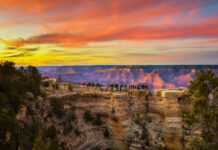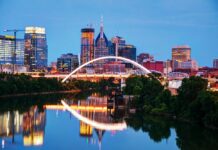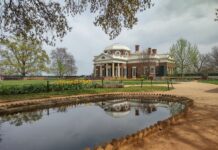 Starting in the town of Rehoboth Beach, avoid the summer traffic snarl on Rehoboth Avenue by turning left on Columbus Avenue (right after the fake Cape Henlopen Lighthouse) and heading for the North Beach area. About a half-mile away is Deauville Beach, a small slice of heaven amid mostly private North Shores. This postage stamp-sized patch of sand and surf is nestled between two private beaches and features tangles of sand dunes and sea grass, and a rented umbrella-free view of the ocean. Gordon’s Pond Nature Preserve, which is part of Cape Henlopen State Park (302-645-8983), was a swampy wetland in the late 1600s, but gradually the ocean wind and waters combined to form a pond. The 1.5-mile pond trail is dog-friendly (pooches need to be on leashes) and walkers can spot monarch butterflies, otters, ospreys and American black ducks. The gorgeous beach stretches beyond Gordon’s Pond. There is plenty of parking (you pay a day fee upon entering the park) and strategically located Spot-A-Pots.
Starting in the town of Rehoboth Beach, avoid the summer traffic snarl on Rehoboth Avenue by turning left on Columbus Avenue (right after the fake Cape Henlopen Lighthouse) and heading for the North Beach area. About a half-mile away is Deauville Beach, a small slice of heaven amid mostly private North Shores. This postage stamp-sized patch of sand and surf is nestled between two private beaches and features tangles of sand dunes and sea grass, and a rented umbrella-free view of the ocean. Gordon’s Pond Nature Preserve, which is part of Cape Henlopen State Park (302-645-8983), was a swampy wetland in the late 1600s, but gradually the ocean wind and waters combined to form a pond. The 1.5-mile pond trail is dog-friendly (pooches need to be on leashes) and walkers can spot monarch butterflies, otters, ospreys and American black ducks. The gorgeous beach stretches beyond Gordon’s Pond. There is plenty of parking (you pay a day fee upon entering the park) and strategically located Spot-A-Pots.
Continuing north on Route 1, head out of Rehoboth about 12 miles (almost to Milton) and turn right on Route 16 East to Broadkill Beach, which is a sheltered, “Summer of ‘42” beach town on the Delaware Bay.
 In Broadkill Beach, time stands still. There is no boardwalk, no souvenir shops, but there is a general store, a Ralph’s Pretty Good Grocery kind of place, where doughnuts are made fresh every day.
In Broadkill Beach, time stands still. There is no boardwalk, no souvenir shops, but there is a general store, a Ralph’s Pretty Good Grocery kind of place, where doughnuts are made fresh every day.
And there is abundant nature. Broadkill abuts the Prime Hook Wildlife Preserve (more on that later), which contains precious wetlands and is on the eastern flyway for migratory birds. Bird-watchers will want to bring binoculars. The beach is also a horseshoe crab sanctuary— 2.5 miles of the 3.8-mile beach is home to the hard-shelled creatures.
Beach houses hug the shoreline, but there is prime space for walking, tanning and surf-fishing— just stay off the sand dunes. At the end of Bayshore Drive is Beach Plum Island Nature Preserve (302-645-8983) where, for $5 a day (out of state, $2.50 for Delaware residents) you can experience some of the most pristine and quiet beaches in the area. It is a popular dog-frolicking area, as well as a great place to find driftwood.
Four-wheel-drive vehicles are allowed up to the beach for a spin around on the sand. This part of Delaware Bay is also an excellent spot for windsurfing.
Further along Route 16 is Prime Hook National Wildlife Refuge (302-684-8419), established in 1963 to preserve coastal wetlands as a wintering and breeding habitat for migratory waterfowl. The refuge’s 8,817 acres are ideal habitat for migrating ducks, geese and shorebirds, and are also home to woodland and grassland birds, reptiles, amphibians and mammals.
Much of this splendid flora and fauna can be observed via four walking trails (dogs on leashes are welcome) that wind around the creeks and ponds. There is even a boardwalk through the marshlands for those who miss the slap-slap sound of wood against their shoes; otherwise, the trails afford that satisfying, soft crunch of pine needles and cones underfoot.
Turkle and Fleetwood ponds, as well as Prime Hook Creek, are open to sport fishing. Canoers have more than 15 miles of streams and ditches to traverse and there are several boat-launching ramps (and rentals) at the various ponds. The harsh winter has left the roads to the ponds full of potholes, so be warned that roaring through the refuge could result in flat tires and missing hubcaps.
Continue up Route 16— perhaps stopping at West Produce for homemade mixed berry or strawberry rhubarb pie and ice cream— to Route 1 and make a right, going north again. Less than a mile up the road, turn right on Prime Hook Road for access to Prime Hook, Shorts and Fowler beaches.
You are still in wildlife refuge territory on this beautiful ride back to Delaware Bay— if you see turtles crossing the two-lane road, you must stop and let the critters pass. The squiggly road is flanked by freshwater marshes on both sides and the only sounds you will hear aside from the car engine are the call of birds, the faint roar of the ocean and the croaking of frogs.
Prime Hook and Shorts beaches offer miles of windswept, curving shoreline, but Fowler is the wildest and most remote spot of them all. Solitude seekers will want to climb over the sand dunes for spectacular views and privacy.
A bit farther north on Route 1 is the turnoff for Slaughter Beach, population 133. This is definitely a place to visit prepared, since there is no hotel, no grocery store and no gas station— although once there was a boardwalk. What does remain is the red-shingled, beleaguered Mispillion River Lighthouse, the only wooden-frame lighthouse still standing in Delaware.
And, of course, there’s the beach, which is low-key and largely undiscovered— except on Fourth of July, when the Fire Department hosts fireworks and folks come from miles around. Slaughter Beach is also home to the horseshoe crab migration and it is said that the name comes from the crustaceans that wash up on shore and die every year when the horseshoe crabs come to the shallow water to lay their eggs— each laying as many as 80,000— and the low tide strands them and they are left to die, thus the annual “slaughter.”
Those seeking an alternative to Bethany or Dewey Beach might want to travel up Route 26 north (turn on County Road 346) to Holt’s Landing, a little-known facet of the Diamond State’s park system. The 203-acre area contains a variety of landscapes, from bayshore beach to grassy fields and hardwood forests— from the park you can see all of Indian River Bay.
The park is also home to the only pier on Delaware’s Inland Bay built specifically for crabbing. The pier is open daily from 8 a.m. until sunset. The park also has myriad places for picnicking, with tables and grills under shade trees, while the grassy lawns overlooking the bay invite sunbathing.
In the Laurel, Del., area (Route 24) you will find Trap Pond State Park (302-875-2392), which boasts the largest stand of bald cypress trees in the United States. Hiking trails surround the pond, offering glimpses of great blue herons, owls, hummingbirds and bald eagles.
Jayne Blanchard is a Baltimore-based free-lance writer.




